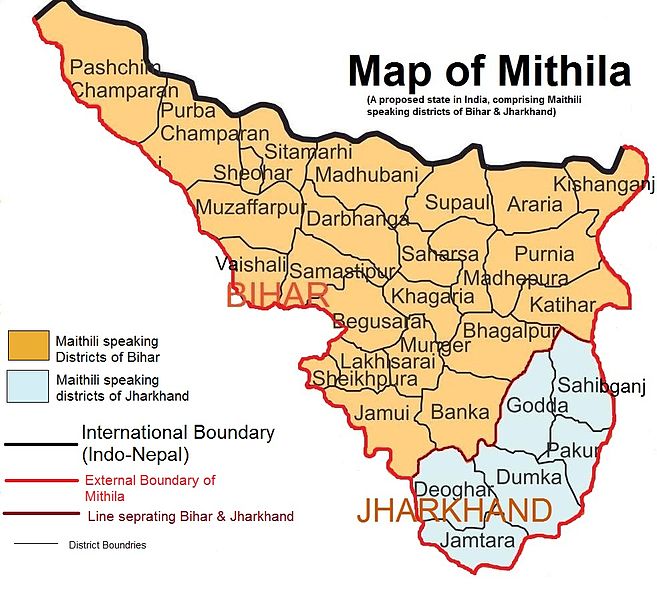Description

Disclaimer: Copyright infringement not intended.
Context
- Bihar Chief Minister recently launched a Rs 72-crore development plan for Goddess Sita’s birthplace at Punaura Dham in Sitamarhi.
Details
- Mithila, also known as Tirhut or Mithilanchal, is a historical and cultural region located in the eastern part of India and the southern plains of Nepal.
- It holds significant cultural, historical, and artistic importance, particularly in the context of art, literature, and traditions.
Geographical and Historical Context
- Geography: Mithila spans across the northern parts of Bihar in India and extends into the Terai region of Nepal. The region is primarily characterized by its fertile plains formed by the rivers Gandak, Bagmati, Kamala, and others.
- History: According to Hindu mythology, it is believed to be the birthplace of Sita, the consort of Lord Rama. Ancient texts like the Vedas and epics like the Ramayana mention Mithila as a prominent kingdom.

References to Present-day Bihar in the Ramayana:
- Sita's Birth and Mithila: Sita, also known as Vaidehi, Janaki, or Sita, was found in a field being ploughed by King Janak in Mithilapuri, associated with present-day Mithila, which covers areas like Darbhanga, Madhubani, Sitamarhi, Supaul, Saharsa, Madhepura, and parts of Bihar and Nepal.
- Ram and Laxman's Travels: According to Valmiki's account, Ram and Laxman, accompanied by Maharishi Vishwamitra, visited various sites in Bihar. This included stops at Chitrakoot, the confluence of Ganga and Saryu in Saran district, Siddhashram near the Ganga in present-day Buxar, and Vaishali, where they were welcomed by King Sumati. They also visited Ahalya's ashram, now known as Ahirouri in Mithilapuri (Darbhanga).
- Wedding of Ram and Sita: Mithilapuri was the site of Ram and Sita's wedding, where Ram broke Shiva's bow.
- Geographical Extent of Mithila: In the Vishnu Puran, Mithila is described as north of the Ganga and south of the Himalayas. Historical texts like the Ain-e-Akbari and revenue records of the erstwhile United Provinces mention the geographical boundaries of Mithila.
- Sita's Birthplace: The birthplace of Sita, initially believed to be at Janaki Sthan in Sitamarhi, was later researched to be Punaura Dham, supported by Valmiki Ramayana and travelers' accounts.
- Janakpuri in Nepal: Janakpuri, now known as Janakpur in Nepal, is a modern name for Mithilapuri. It became a part of Nepal after the 1816 Indo-Nepal treaty and has been included in the Ramayana Circuit by the governments of India and Nepal.
- Sitamarhi: Historical references by archaeologists like Alexander Cunningham mention Sita-Marhi, located north-west of Darbhanga and close to the Nepal border. It is associated with temples dedicated to Sita.
Cultural Significance
- Art and Crafts: Mithila is renowned for its distinctive art form called Madhubani painting, which originated here.
- Literature: The Maithili language, a regional Indo-Aryan language, is spoken and has a significant body of literature. The region has produced renowned poets, scholars, and writers. Vidyapati Thakur, a medieval poet, is highly revered for his contributions to Maithili literature.
- Traditions and Festivals: Various festivals like Chhath Puja, a sun-worshipping festival, hold immense significance. Other festivals like Teej, Holi, and Diwali are celebrated with fervor, showcasing the region's vibrant cultural fabric.
Social and Economic Aspects
- Agriculture: Agriculture forms the backbone of the economy in Mithila. The fertile plains support the cultivation of rice, maize, pulses, and other crops. The region's agricultural productivity has contributed significantly to the local economy.
- Social Structure: The society follows a patriarchal system, and traditional norms and values play a significant role in shaping social interactions and hierarchies.
Bihar Government's Plans for Punaura
- The Bihar government, in coordination with religious trusts and boards, plans to develop Punaura, identified as Sita's birthplace, into a pilgrimage site.
- The development plans include the renovation of temples, the creation of circumambulation paths, development of sacred areas like Luv Kush Vatika, Sita Vatika, Sita Kund, and a meditation mandap.
- Additionally, a significant temple dedicated to Sita is planned to be constructed within Sitakund.

Conclusion
Mithila stands as a repository of ancient heritage, cultural richness, and artistic excellence. Its contributions to art, literature, and traditions have left an indelible mark on the cultural tapestry of India and Nepal. Despite modern advancements, Mithila continues to cherish its heritage while embracing new avenues for growth and development.
|
PRACTICE QUESTION
Q. Which of the following regions is historically associated with the origin of Madhubani painting and is known for its rich literary heritage in Maithili language?
A) Malwa
B) Mithila
C) Marwar
D) Murshidabad
Answer: B)
|















